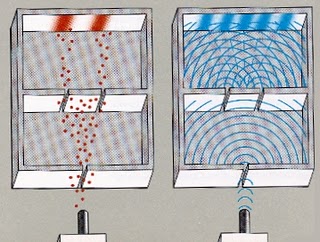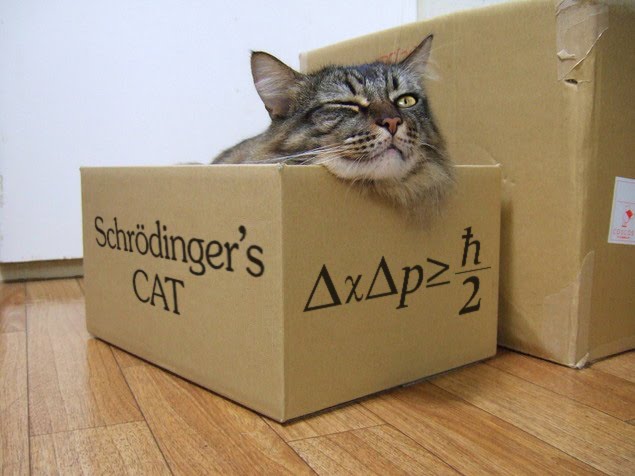Linguofreak
Well-known member
I've been wondering lately what would happen if we took the double slit experiment and, instead of trying to measure *which* path the particle takes, rather measuring whether it takes one path or both.
For example, we set up a pair of detectors at either slit, and wire them to an XOR gate. We fire a particle at the slits and observe a count on the screen behind the slits. There are then two possibilities for what we see at the output of our XOR gate just before we observe the count on the screen:
1) One of the detectors observes the particle, and the other doesn't (or the two detectors are in a superposition of detection/no detection such that their outputs are opposite of each other), which causes the output of the XOR gate to emit a count (per the truth table for XOR), so we know that the particle took a single path, but *we don't know which path it took* (unlike the usual formulation of the double slit experiment where we detect which path the particle took).
2) The two detectors both make the same observation, and the XOR gate stays low. We can't actually tell from just that whether either detector detected a particle or not, or was in a superposition of detection/no detection, but we know that we fired a particle and got a count at the screen but no count from the XOR gate, so we know that the particle traveled from the source to the screen, and that it did not a single path (or we'd get a count from the XOR gate), thus we can say that it took both paths.
If we place another pair of detectors immediately behind the ones wired to the XOR gate, but the second set are set up to give us "which path" information, we'll obviously see the following results:
1) We'll observe no interference pattern at the screen, just as in the usual double slit experiment.
2) We'll see a 50/50 distribution of detections at the left and right slits for both the "one path" and "two path" cases, as well as for the total number of detections. (Unless the source is off-center, in which case it will no longer be 50/50, but will still be the same for "one path" and "two path").
3) We'll see the same distribution of XOR gate counts for both left slit and right slit detections.
But if we *don't* have the left/right detectors there, what will we see? Will we still get an interference pattern overall? If we look at where "one path" and "two path" counts end up on the screen will we still observe an interference pattern in either or both distributions?
Finally am I right in thinking that |one path> and |two path> are related to |left> and |right> such that:
|two path> = (|left> + |right>) / sqrt (2), and |one path> = (|left> - |right>) / sqrt (2) ?
For example, we set up a pair of detectors at either slit, and wire them to an XOR gate. We fire a particle at the slits and observe a count on the screen behind the slits. There are then two possibilities for what we see at the output of our XOR gate just before we observe the count on the screen:
1) One of the detectors observes the particle, and the other doesn't (or the two detectors are in a superposition of detection/no detection such that their outputs are opposite of each other), which causes the output of the XOR gate to emit a count (per the truth table for XOR), so we know that the particle took a single path, but *we don't know which path it took* (unlike the usual formulation of the double slit experiment where we detect which path the particle took).
2) The two detectors both make the same observation, and the XOR gate stays low. We can't actually tell from just that whether either detector detected a particle or not, or was in a superposition of detection/no detection, but we know that we fired a particle and got a count at the screen but no count from the XOR gate, so we know that the particle traveled from the source to the screen, and that it did not a single path (or we'd get a count from the XOR gate), thus we can say that it took both paths.
If we place another pair of detectors immediately behind the ones wired to the XOR gate, but the second set are set up to give us "which path" information, we'll obviously see the following results:
1) We'll observe no interference pattern at the screen, just as in the usual double slit experiment.
2) We'll see a 50/50 distribution of detections at the left and right slits for both the "one path" and "two path" cases, as well as for the total number of detections. (Unless the source is off-center, in which case it will no longer be 50/50, but will still be the same for "one path" and "two path").
3) We'll see the same distribution of XOR gate counts for both left slit and right slit detections.
But if we *don't* have the left/right detectors there, what will we see? Will we still get an interference pattern overall? If we look at where "one path" and "two path" counts end up on the screen will we still observe an interference pattern in either or both distributions?
Finally am I right in thinking that |one path> and |two path> are related to |left> and |right> such that:
|two path> = (|left> + |right>) / sqrt (2), and |one path> = (|left> - |right>) / sqrt (2) ?



